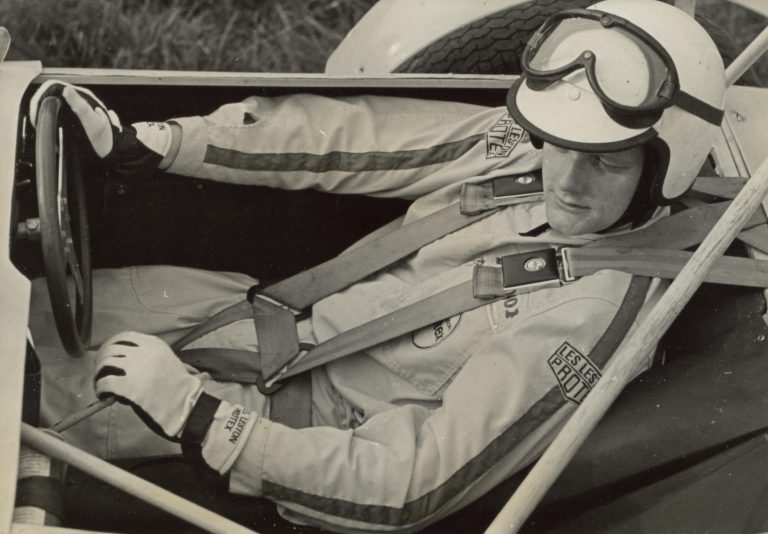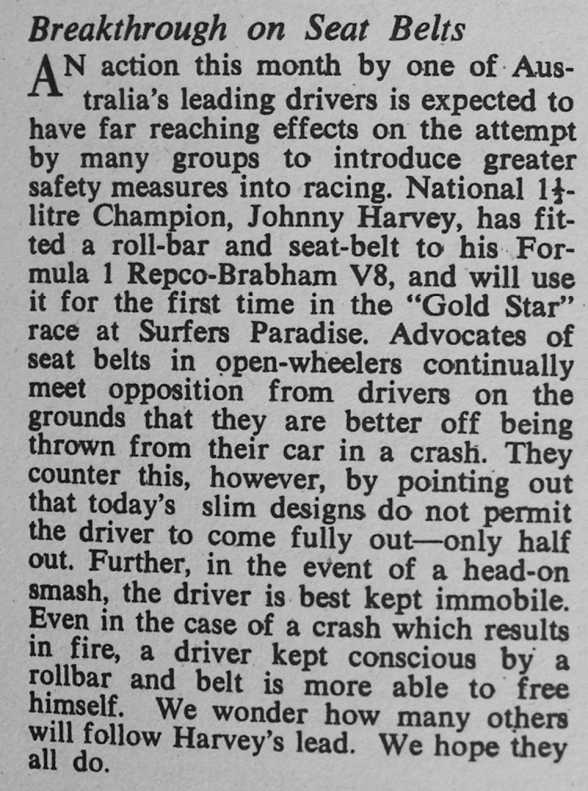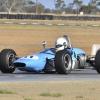It was, really, a gathering storm...
While Dr. Michael Henderson was researching the desirability of fitting harnesses to open race cars - both sports and open-wheeled - in the UK in 1967, there was an undercurrent of belief being revealed in Australia that these should be used. And while Michael was doing his research he was 'practising what he preached' by designing, arranging the manufacture of and racing himself with the prototypes of these belts:
Michael Henderson in his U2. A big advance on previous designs, this was the harness used in his U2. Fellow racer Max Mosley had one as well.
That was some pretty serious action, whereas here in Australia it was mostly words. In Racing Car News in April, 1967, Jim Sullivan's Philosophy column...
Jim Sullivan and 'Philosophy'. After a couple of years racing in England, Jim returned with some firm opinions and worked with Max Stahl to present these in the hope that the sport would head in better directions.
...went into some serious detail about safety equipment in general. We'd gone through the fire-resistant race suit issue in preceding years and Jim focussed on roll cages in tin-tops, rollover bars in open cars and safety belts in all. This was published at the same time as Wally Mitchell was to succumb to injuries and burns in hospital after crashing at Symmons Plains, so it was timely.
Of course, the key to staying safe is to stay in the car. That's what Michael's research concluded and one of the points Jim pushed in his column. He referred to the semi-ejection of Jack Brabham a few weeks before at Pukekohe and how it could have turned out quite badly for Jack.
No doubt the strong readership of RCN at that time meant that a lot of people looked at the article and, perhaps, started thinking. And just two months later we saw Bill Stephens ejected from his overturning Cooper at Hume Weir and being killed to leave a wife and family behind.
Similar things were being written, principally by Michael, in the British magazine, Motor Racing. But he was in a position to back his views with hard facts and figures gained from studying every open-car crash on British circuits that year. At some point Jackie Stewart applied his analytical mind to the issue and before the German Grand Prix (August 6, 1967) he had BRM fit belts to his car.
In Australia there was another driver who wasn't happy to go without belts any longer, Johnny Harvey. Around the end of July he had a harness fitted and his first race with it was at Surfers Paradise on August 27. I don't have my copy of The Rise and Fall of Peter Brock here, but my recollection of Harvey's discussion about this was that he'd been through the 'better to be thrown out' argument in his speedway years and had learned there that it just wasn't the case.
The Racing Car News news item that told readers of Harvey's move contained some interesting phrasing. From the 'Breakthrough' in the heading through the 'attempts by many groups' to 'Advocates... continually meet opposition...' it shows that there was current discussions taking place.
Bits & Pieces, August 1967. It's clear that the editor, Max Stahl, was hearing positive suggestions from a range of people.
At the same time, a friend of Fred Gibson's was in England and saw some of Michael's articles. He could see the sense in them and, as 1968 rolled in he called on Michael. He had learned that Michael was emigrating to Australia and wanted to talk to him about these safety issues. When he learned that there was an Elva BMW going with Michael he suggested that Fred might be the ideal person to take care of the car once it arrived.
And still at the same time, Harvey changed teams. As Spencer Martin retired, John took his seat in the Bob Jane team - and he took his harness with him. This, I'd suggest, was perfectly okay by Bob, who knew from an incident at Sandown in his Elfin Mono that getting a taste of hospital food isn't the ideal way to finish up after a race meeting. The BT11a had a harness fitted as well as the Repco V8.
The Hendersons arrived in Australia in February, 1968. By the end of March Michael had made contact with Fred Gibson and, as a part of his discussions with him, showed him the evidence necessary for Fred to decide that a 6-point harness should be fitted to the Niel Allen Brabham BT16 Climax he drove. Strangely, the other Niel Allen cars were not fitted out with the belts Michael had shipped in from England, "Niel was a resister," says Michael.
The time moved on, through the Tasman Cup meetings of 1968, fortunately without serious crashes. But that all changed at Bathurst in April. Harvey was there in a car lacking a harness, again I can't quote him because I don't have the book here, but Harvey explains in that the timing of the preparation of the new car Jane bought from Brabham for him - and that they took the belts to Bathurst to fit, but weren't happy with the circumstances and it was finally decided to run without them. The only car at the meeting with a harness was Fred Gibson's.
What I recall from the book is that he tells of hearing a nurse say something like, "A shame he won't make it through the night, such a good looking young man."
Michael described things in an analytical article in Racing Car News:
Quote
Elsewhere you will read how Johnny Harvey narrowly escaped with his life, and how Leo Geoghegan was lucky to get away with severe bruising in crashes during practice at Bathurst.
Harvey was half-ejected, slammed his head on something hard, and fractured his skull. (Crash helmets only add a few mph to the survivable impact speed). What is extraordinary is that Harvey, a safety-minded driver, usually wears restraint harness – but not on this occasion!*
Geoghegan spun at high speed, clipped a tree, mowed down a row of fence posts – then, at not more than 20 – 30 mph, the Lotus gently tipped him out. At this speed he was still bruised enough to keep him quietly at home for a good few days. If he had been thrown out earlier in the shunt, he could be in hospital now. Neither his car nor Harvey’s suffered any cockpit distortion to speak of – though both were extensively bent otherwise.
The 6-point harnesses immediately became better-known as Michael talked to people about them, the Mildren team fitted one to Kevin Bartlett's car overnight and it was becoming obvious that greater interest was being shown. Especially after Michael's analysis was published in the same issue as the race report. Frank Matich was among the number who fitted his harnesses. But it was even with some sadness that he wrote about these Bathurst crashes as by now Jim Clark, who'd been someone both Michael and his wife Norma had tried to convince him to strap himself in, had been killed at Hockenheim.
Michael's small stock of belts slowly found their way into a few cars, but it seems that something dramatic was needed to convince more drivers and, particularly, the legislators who have the authority to make rules which would force drivers to use them. It's clear that Michael kept promoting the belts and eventually he wore down the resistance shown by Niel Allen. And that was a very good thing.
On July 21, Niel had shown his growing speed and confidence in the McLaren M4a by eclipsing the time Piers Courage had done at Warwick Farm in the car in February. On July 26 he was at Lakeside and practising for the Gold Star race. He was simply stunning, the quickest of all present on this Friday afternoon. On Saturday he went out to confirm his pace in official practice and it didn't go nearly so well.
I have often described the horrific scene which confronted Bob Levett and myself as we stood watching up on the hill above the infamous kink at the end of Lakeside's straight. From this point the cars are seen entering the kink, but as they drift to the outside exiting the corner they go out of sight because of the embankment. And so did Niel's McLaren.
But instead of emerging in the braking area heading for the Karrussell, we watched in fear as a cloud of dust rose and the underside of the car came into sight, the alloy undertray glistening in the sun, along with the chromed suspension members, as it flew backwards perhaps twenty, maybe thirty, feet off the ground, still doing a speed on the high side of 120mph. They were the last seconds that the car was more or less intact, in moments it met the ground and pieces flew in every direction as it tumbled and shed bodywork, suspension members, its engine and gearbox, the roll bar and the rear of the tub.
Niel had only the driver's compartment around him, it was lying on its side and he was unconscious. It was easily the most terrifying crash I've ever seen, we were sure he was dead, but the harness did its job and Niel was to survive.
At this point I feel Michael Henderson's work in this field was vindicated. It was only a few weeks, however, before there was further proof. At Catalina Park on August 18 two crashes went a long way to doing this.
I was late arriving that day and drove in as there was a pause in a Touring Car race, I didn't see the Lotus Cortina crash which caused this. But later in the day I did see Ian Fergusson's Lotus 27 skate off the straight in slippery conditions while leading his second race of the day. Again it was a scene to bring one to feel a great deal of apprehension for the likeable farmer driving the car:
In the rough. After the first bounce the 27 is heading for its final destination as Fergusson is being tossed about like a rag doll - but remains strapped in the car.
The sequence of Darrel Bird photos continues to show how being constrained and uninjured enabled Ian to get out of the car as it burst into flames:
On the other hand, New Zealander John Ward refused to wear belts in his Lotus Cortina. That refusal cost him his life, he became the only Touring Car driver to die in a race in Australia in more than a decade.
.
Edited by Ray Bell, 12 October 2022 - 10:14.



























